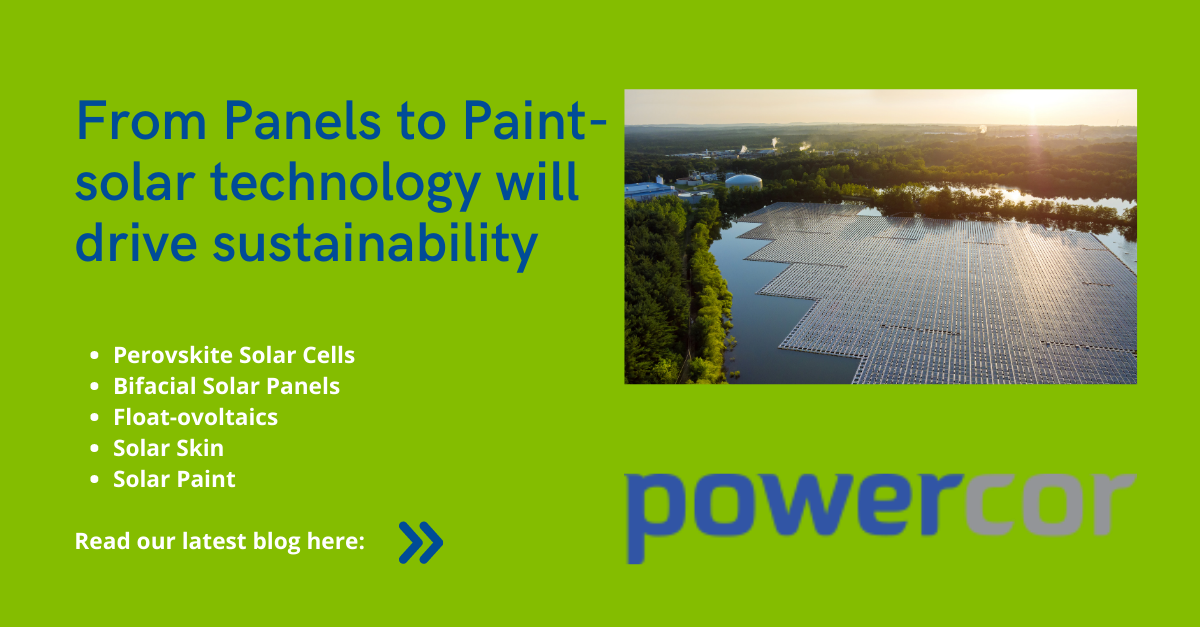As the world continues to develop more efficient ways to navigate to a sustainable future, solar power has become the mainstay of many efficient energy programmes.
Such is its importance that solar power methodologies are being transformed with new technology that is changing the way we approach the use of energy. It comes against a backdrop of rapidly rising energy costs as the supply of fossil fuels and energy are impacted by the pressure in the global supply chain. (Powercor Blog » Sustainability – Key Strategies to Controlling Rising Energy Costs)
There are many recent technological advances that have made solar energy more efficient and affordable. In this article, we explore several that are showing significant potential.
Perovskite Solar Cells
A new form of solar technology that has boosted efficiency is perovskite solar cells. These solar cells are less expensive and simpler to produce since they use perovskite crystals rather than conventional silicon.
A coating of perovskite material is deposited onto a substrate, such as glass or plastic, to create perovskite solar cells. Electrodes are positioned on either side of the cell to collect the electricity that the perovskite layer produces as a result of absorbing sunlight.
The high efficiency of perovskite solar cells is one of its key features. Perovskite solar cells have recently attained efficiencies of around 25%, which are on par with conventional silicon-based solar cells. Perovskite solar cells are an attractive technology for producing solar energy on a big scale because of their great efficiency.
The affordability of perovskite solar cells is another benefit. Perovskite materials are easier to make and far less expensive than conventional silicon compounds. This might contribute to lowering the price of solar energy and increasing its affordability.
Perovskite solar cells, though still in their infancy, face a number of obstacles that must be addressed before they can be extensively used. Their stability is one of the primary problems. When perovskite materials are exposed to heat or moisture, they are susceptible to deterioration, which over time can limit their effectiveness. More stable perovskite materials that can resist challenging environmental conditions are now being developed by researchers.
Bifacial Solar Panels
Solar panels that are bifacial collect light from both directions, boosting their efficiency by 30%. They can use the light that is reflected off the local ground or other surfaces to produce electricity.
Bifacial solar panels’ efficiency can vary based on a number of variables, such as the albedo (reflectivity) of the ground, the sun’s angle, and the type of mounting mechanism being utilised. Yet, in general, the extra energy they can produce compared to conventional solar panels makes them a popular option for large-scale solar projects.
The adaptability of bifacial solar panels is one of their benefits. They can be positioned to maximise their energy output according to the location of the sun and mounted on the ground or a building.
Durability is a further benefit. They are less vulnerable to shading and other environmental conditions than conventional solar panels since they are made to capture sunlight from both sides. Moreover, hot spots, which can develop when a section of a solar panel is shadowed and harm the cells, are less likely to happen with bifacial solar panels.
Solar Skin
The energy industry is expected to be significantly affected by solar skin as a technology. Any surface can have this thin film placed on it to transform it into a solar panel. Although this technology is still in its infancy, it has the potential to revolutionise the way we see solar energy.
The film is a promising new method of generating solar energy without the need for conventional heavy solar panels because it contains solar cells that can convert sunlight into electricity.
It may be tailored to blend in perfectly with the surroundings by being made to match the colour and texture of any surface.
Solar skin is still capable of generating a considerable quantity of energy. It is made to be strong and long-lasting, resisting the effects of the weather and other environmental conditions.
As it can be made in huge quantities and applied to any surface, Solar Skin is anticipated to be more cost-effective than conventional solar panels. This will eliminate the need for pricey and obtrusive solar panel installations.
Floating Solar
As more nations turn to solar energy, the location of large-scale solar farms will become a problem and the development of floating solar has started to increase.
Floating solar offers many benefits and are also referred to as floating solar panels or floating photovoltaic (PV) systems. Floating solar farms can offer a new option to produce solar energy without using up important land resources because bodies of water are frequently underutilised.
A cooling impact from floating solar farms can improve the efficiency of the solar panels and lessen water evaporation from bodies of water.
In addition to reducing the growth of algae and other aquatic plants, the platforms on which the solar panels are mounted can create new habitat for fish and other aquatic species.
Solar Paint
Solar paint is a novel material that in future may be used to paint surfaces to generate electricity from sunshine, much like solar skin. Nanoparticles in the paint absorb light and turn it into electricity. The creation of solar paint is still in its infancy, and scientists are attempting to increase its effectiveness and robustness. Once created, it will offer more variety, be reasonably priced, and occupy very little space.
You can read more about why commercial property owners should be thinking about solar power here (https://www.powercor.co.uk/blog/5-reasons-why-commercial-and-domestic-property-owners-should-consider-solar-power/)






